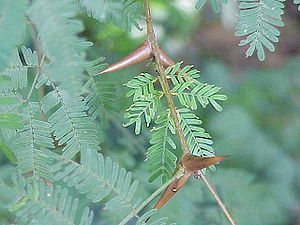Myrmecophylaxis
Under Myrmekophylaxis means a symbiosis between ants and plants in which the plants shelter and food to provide. These types of plants are known as myrmecophytes . The ants attack herbivores with bites and poison and / or bite lianas and other vegetable competitors. The form of living space and food supply for the ants is different for the various taxa . Myrmecophylaxis is optional; Plants without an ant partner also survive, but they have to produce food poisons or suffer more damage.
Examples
Acacias

Some of the approximately 700 acacia species have particularly large stipule spines ( domatia ), such as Acacia collinsii or Acacia sphaerocephala . Because of the size and shape of the thorns, these acacias are often referred to as "buffalo horn acacias" ( English : buffalo thorn ). The stipule spines are hollowed out by a queen ant (e.g. A. sphaerocephala from the genus Pseudomyrmex ) and thus become the living space of the ants.
Extra-floral nectaries (glands for excreting sugar-rich nectar outside the flower ) serve as feed . In A. collinsii, these are at the base of the petioles. In addition, protein and fat-rich food bodies are formed on the leaflets . These are called Belt's corpuscles .
Acacia individuals that have not yet harbored an ant colony have to produce many secondary metabolites , i.e. food poisons. Acacias with ants save their production. The large thorns keep large mammals away from the acacia leaves, but not herbivorous insects . In addition, various savannah-dwelling mammals such. B. the giraffes have learned to pluck the leaves very skillfully with their lips and tongue .
Macaranga
Some species of the paleotropic genus Macaranga ( Euphorbiaceae ), such as B. Macaranga triloba , have also entered into a close relationship with ants. Their partners are ants of the genus Crematogaster from the subgenus Decacrema .
The ants live in the hollow shoot axes . As a food, Macaranga tribola offers three sources. At the ends of the leaf veins on the edge of the leaf there are extra-floral nectaries that supply the ants with plant sap containing sugar. Often there are also real cultures of scale insects in the hollow stem axes , which the ants milk like the aphids and thus also receive sugar. At the base of the leaves there are stipules that produce food bodies. These are called Beccari's corpuscles .
To protect the ants from competition from other ants and insects, some Macaranga species even form special waxes on the surface (epicuticular waxes) of the shoot axes. Insects that have not adapted cannot stay on them and therefore cannot run around on the stem of the plant.

Cecropia
Most (but not all) species of the genus Cecropia , native to the tropics of the New World, form a symbiosis with ants of the genus Azteca . The hollow shoot axes are thickened at the leaf attachment points (nodes) and form chambers there through a partition. Most of the time above the leaf bases, the shoot axes are also very thin, so that they can be bitten through by an ant. The chambers then serve as living space. As with Macaranga, scale insect cultures in the hollow shoot axes serve as food . On the underside of the base of the petiole, food bodies are also formed, which are protein and fat suppliers. They are referred to here as Müller's corpuscles .
Further examples
Further examples are all kinds of plant genus Myrmecodia , and some species of bromeliads genera Brocchinia and Tillandsia .
literature
- IW Bailey: The anatomy of certain plants from the Belgian Congo with special reference to myrmecophytes Bulletin American Museum of Natural History Vol.XLV (1922) online: PDF ( Memento of December 27, 2004 in the Internet Archive )
- A. Hatada, S. Ishiguro, T. Itioka, S. Kawano: Myrmecosymbiosis in the Bornean Macaranga species with special reference to food bodies (Beccarian bodies) and extrafloral nectaries In: Plant Species Biology , 16 (3) / 2001, p. 241-246
- H. Schenck: Die myrmecophilen Acacia-Arten in: Bot. Jahrb. 50/1914, S. 449-487 online at biodiversitylibrary.org
Web links
- Surface structures of Macaranga sprouts
- Pictures of Cecropia ( Memento from June 14, 2007 in the Internet Archive )